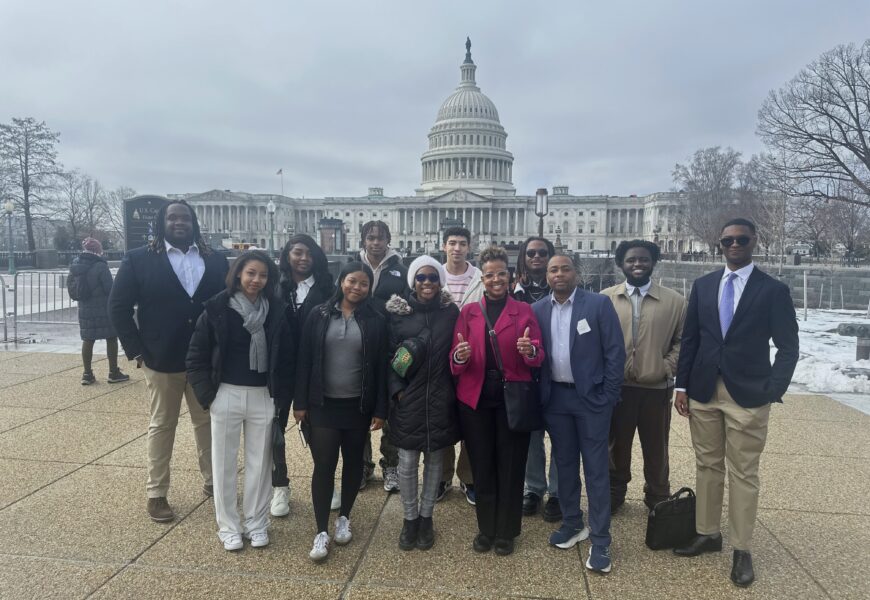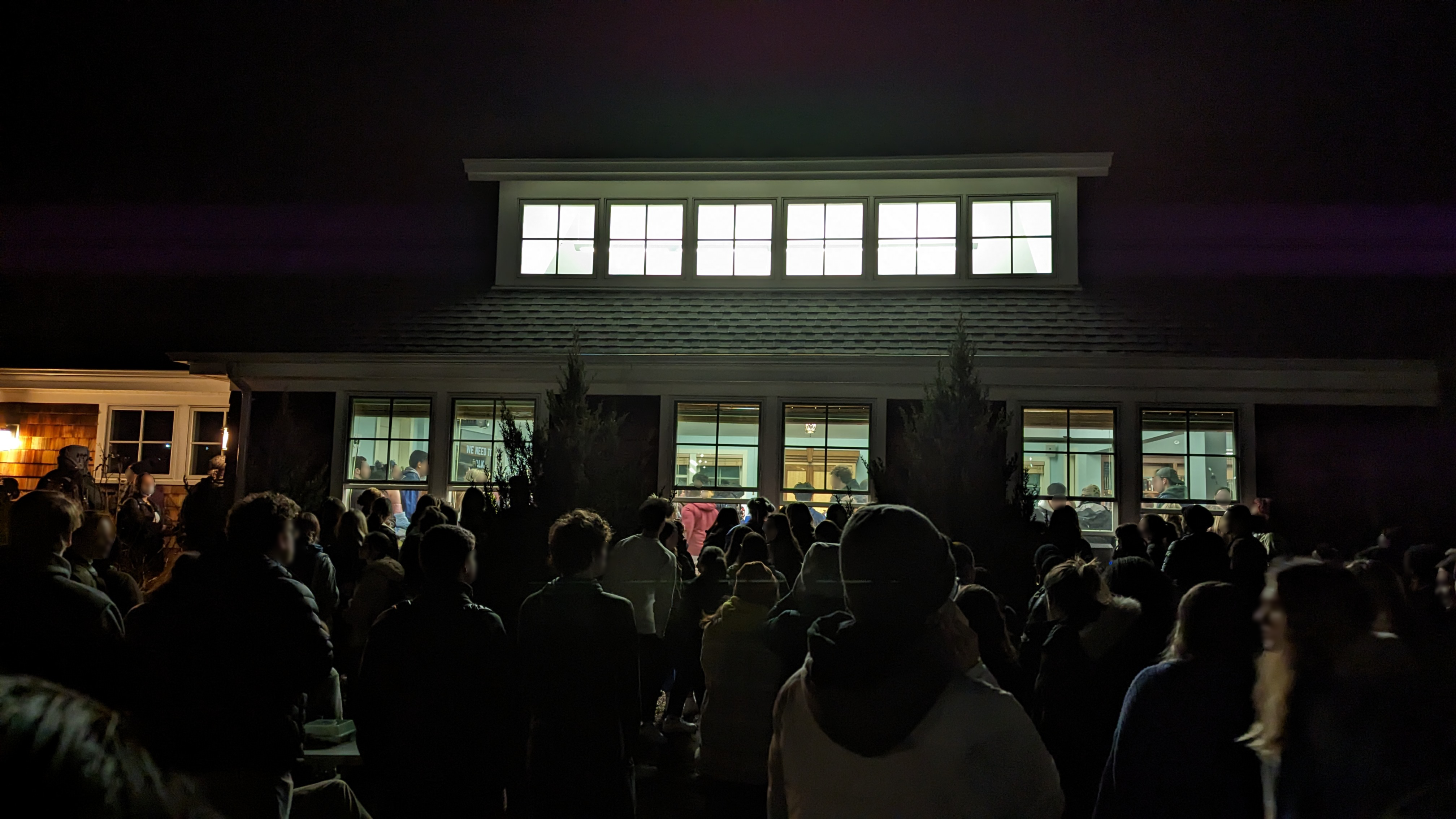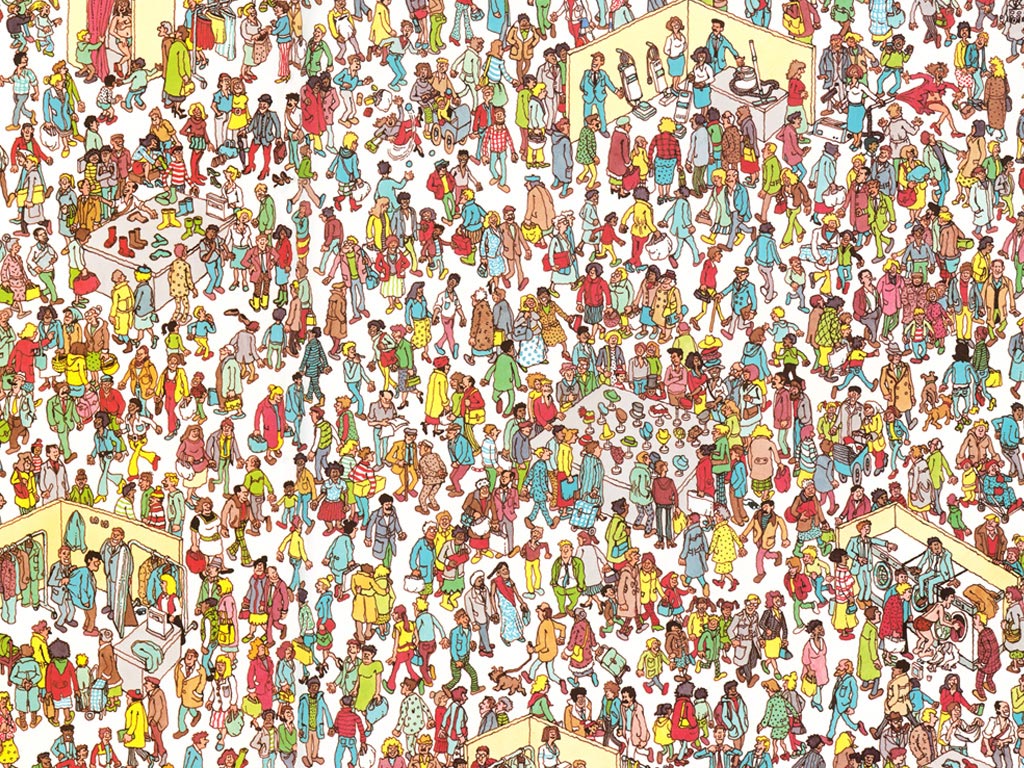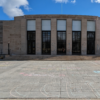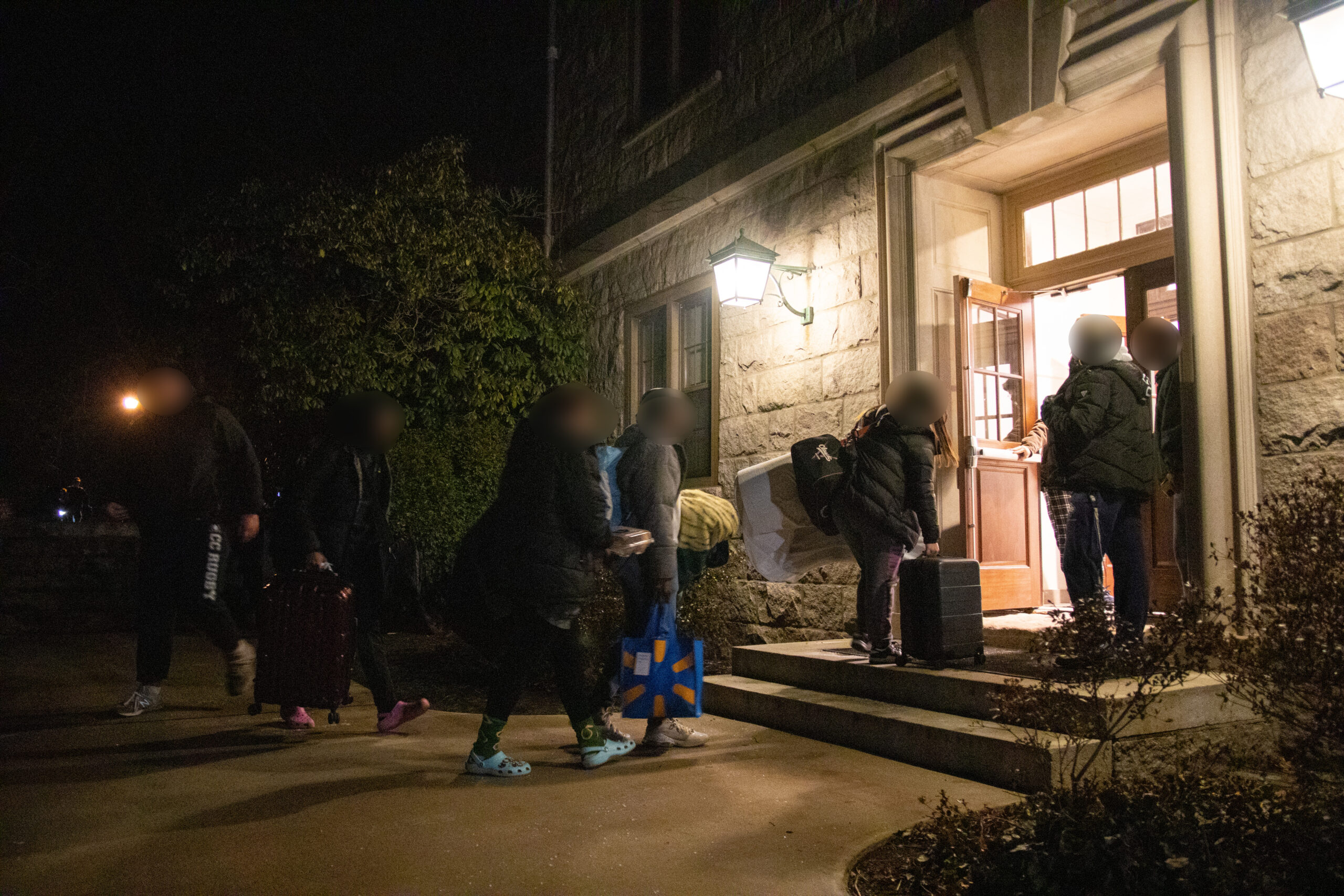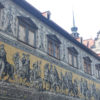Courtesy of Luke Corless
After an early 6 am wake-up, a few train malfunctions and transfers, and a tight Uber ride, a cohort of Connecticut College students arrived in Washington D.C., with 3 days of learning, questioning, and bonding ahead.
Terell Wright ‘25 gave a brief history of how the trip came to be in last year’s iteration and the rationale behind bringing this year’s cohort together.
“After the Fanning protests against President Bergeron in the Spring of 2023, I constantly questioned, ‘How can the college do more to empower Black students?’ When Zale [Peart ‘25] came to me alongside Professor Eileen Kane in the history department, I knew I wanted to commit to helping establish this trip. One facet I found particularly important when planning the retreat was Black career advancement on Conn’s campus. Utilizing my network, first at The New York Times and Capitol Hill and The Washington Post this year, we were able to deliver each cohort an exclusive front seat into Washington’s most consequential spaces.
Selecting this year’s cohort, we especially sought underclassmen students with untapped leadership potential, who can help maintain and cultivate the future years’ cohorts. The enthusiasm and spirit of this year’s underclassmen was contagious and exciting. I can’t wait to see future renditions of this retreat and the unique aspects students will add.”
Thursday served as a first in many ways — for some, it was their first time in Washington. For others, it was their first time at the Capitol. For all, it was their first day as a cohort participating in the program’s schedule, an agenda beginning in the morning with a meeting and conversation with Congressman Joe Courtney.
Representative Courtney entered his office, decorated with photos of Connecticut College and the Groton submarine base, to greet the crew eager with questions. The congressman heard the group’s introductions and gave one of his own. He stressed the importance of every single vote with an inspiring story of his first win for Connecticut’s second district, coming at a margin of 83 votes. He called out to the group to contact their representatives by humbly stating that his office and the offices of most representatives do not know everything. Their staff of just over a dozen needs help from the public to know what is best for their constituents, and the congressman entrusted the cohort to spread that word. As time for voting neared, the group shook the Congressman’s hand and wished him luck on the rest of the day’s work.
One of Courtney’s staff members walked them down the hallway where Congressmen and Congresswomen had offices, left and right, adorning their entrances with associated posters and flags.
Before the tour, students, alongside other tour-goers, were presented with a video introducing the history of America and the significance of Democracy and the Washington D.C. region.
The video gave a fascinating account of the United States. From the resiliency of enduring the War of 1812 and bouncing back from the Great Depression to the work to rebuild Europe post World War II. While the video captured much of American history, notable themes of Native American exclusion and displacement were glossed over. American Imperialism, such as the Louisiana Purchase, the acquisition of Alaska, and the Spanish-American War, were just a few of the many conquests that were not mentioned.
Into the National Sanctuary Hall area of the capital, students saw a number of statues, assembly rooms, and commissioned paintings in the Capitol. For many, the building served as a reminder of this nation’s many influential and inspirational leaders.
An Uber away was The Washington Post, the 2nd most-read paper in the country. Students had the extraordinary opportunity to peek behind the glass security gates and walk amongst some of the best journalists America has ever had — even more than that, they got to talk to some of them, too.
Students were taken through the office, where researchers with multiple monitors worked away at their desks. Journalists discussed pitches in conference rooms, minds and bodies engaged, and ideas flowing over. The Washington Post motto, a quote from former WAPO Executive Editor Ben Bradlee, hangs as a spectacle in the middle of the office.
“The truth, no matter how bad, is never as dangerous as a lie in the long run.”
Students then went to their very own conference room, where journalist Krissah Thompson met them first to discuss the expansion of journalism off-platform as the editor of the start-up Washington Post Ventures. They were then joined by Carmella Boykin, a host and producer for the Washington Post TikTok team, who gave the group an artistic presentation of her journalism journey as a young person in a newer avenue of journalism. Finally, the pairing of Karen Attiah and Jonathan Capehart joined the group to speak about political journalism and their perspective of journalism under the current presidential administration.
As night fell, students left to enjoy a meal at Jojo’s Restaurant and Bar, a black-owned business with a 1920s ambiance from the nightly jazz performances. More than its ownership, the restaurant is located on University Street, better known as U Street, a historically black area of D.C. home to the Lincoln Theatre, Duke Ellington’s Childhood Residences, and Little Ethiopia. While U Street is seldom known by its former moniker, “Black Broadway,” due to the area’s economic collapse during D.C.’s era of desegregation, it is still a significant part of the city’s black history with major contemporary efforts to maintain stories of its glory days.
Thursday night was full of news of federal firings, RFK Jr.’s confirmation, and President Trump’s call with Russian President Putin. The tension in the city was palpable and clearly made an impact on some of the group. A desire to understand why, where, and how we got to the present moment led to some really powerful conversations. A few group members took to the hotel lobby to voice their concerns and connect on the issues they felt most connected to or were struggling to understand.
In such a confusing and trying time, it is essential to maintain a level head and press into your communities for security and understanding. In a time that is doused in isolation and conflict, having genuine and heartfelt conversations backed by empathy and respect is the only way forward and the recipe for substantial and lasting progress.
The group woke up early for the second day for a career panel of Hale Family Executive Director Persephone L. Hall and Professor Kendell Coker. Executive Director Hall’s experience in a slew of different positions taught the group to be flexible with their careers and be open to change. Professor Coker’s story of being an incredibly gifted student but stuck in environments that were not conducive to his growth was inspiring for all. Hosting a group of primarily urbanites, it was valuable to hear relatable perspectives from professionals who did not mince words while explaining.
The students took the train back toward U Street. The second day’s beauty derived from the group’s first chance to explore DC’s residential areas and more authentic side. Hoping on the metro was a smooth and comfortable experience that gave the cohort a glimpse into the transportation system hundreds of thousands of DC residents use daily to support their city and the federal government.
A few minutes from the metro station was the Mary McLeod Bethune Council House, a gem of Black history nested in Northwest DC. Bethune was a distinguished educator who started the Daytona Literary and Industrial Training School for Negro Girls, which is today Bethune-Cookman University. On top of her work in education, she founded the National Council of Negro Women and became a significant figure in the fight for civil rights. Her estate was full of much of the original furniture and artifacts, giving the group a clear lens into the civil rights movement.
About a mile from Bethune’s home, the group strolled to Howard University. For many of us, it was our first time on the campus of an HBCU, and the experience was spectacular. From the architecture to the fashion to the community, it was unequivocally clear why the University is nicknamed ‘The Mecca.’ The Camels and Bison mingled, with the entire group feeling a strong level of community as they toured classrooms, facilities, and the multitude of green spaces on the campus.
The final full day was to be occupied by, arguably the trip’s crown jewel, the National Museum of African American History and Culture. One of DC’s most visited museums is home to one of the most expansive collections of Black and African-American history accessible to the public in the United States. Starting from the bottom floor in the 1400s with the relationship between Europeans and Africans and the origins of slavery to the top floor that highlights the contemporary black struggle as well as the cultural stamp black people have left on the world. Each floor contains so many artifacts, stories, and information that one trip to the museum would not suffice. From heartbreaking exhibits like the memorial for Emmett Till to Muhammad Ali’s used headgear to beautiful artworks from former Connecticut College professor Barkley Hendricks, there is something for everyone. Before even exploring the museum, we were given the opportunity to meet with Class of 2019 Alum Yves Pierre for lunch and to hear about working in DC post-graduation. Meeting alumni connections in DC was a great part of the trip, giving the cohort a new level of professional depth and purpose to the retreat.
The Black History Month Retreat 2025 was an undoubtable success. The cohort gained profound knowledge of Black history, experienced life on Capitol Hill and in the offices that cover it, as well as coming closer as a group of future black professionals and friends. Thanks must be spread graciously to every person who participated, helped organize, and provided the funding to get the excursion off the ground. We are massively grateful for the many departments, offices, and community members across campus who made this event possible. The college has shown unwavering support for its black community, as detailed by Executive Director Hall,
“Connecticut College is good at making space for Black faculty, staff, and students to be in community with each other. I don’t think it’s the responsibility of an organization to do the work but to make space that allows the work of community building to happen. I appreciate that the traditional things happen – like Genesis, the POCA Fashion Show, and the Stolling Ceremony in Unity – are part of the culture at Conn. I also appreciate that new things can be birthed like the Asante Gala and the Black History Month Trip. I also think students, faculty, and staff have the responsibility to seek out or create those opportunities as well. Those are the things that make Conn special.”
As the Black History Month Retreat 2025 fades into the horizon and the cohort folds back into ordinary life at Conn, the timer for its 2026 iteration has already begun ticking.

